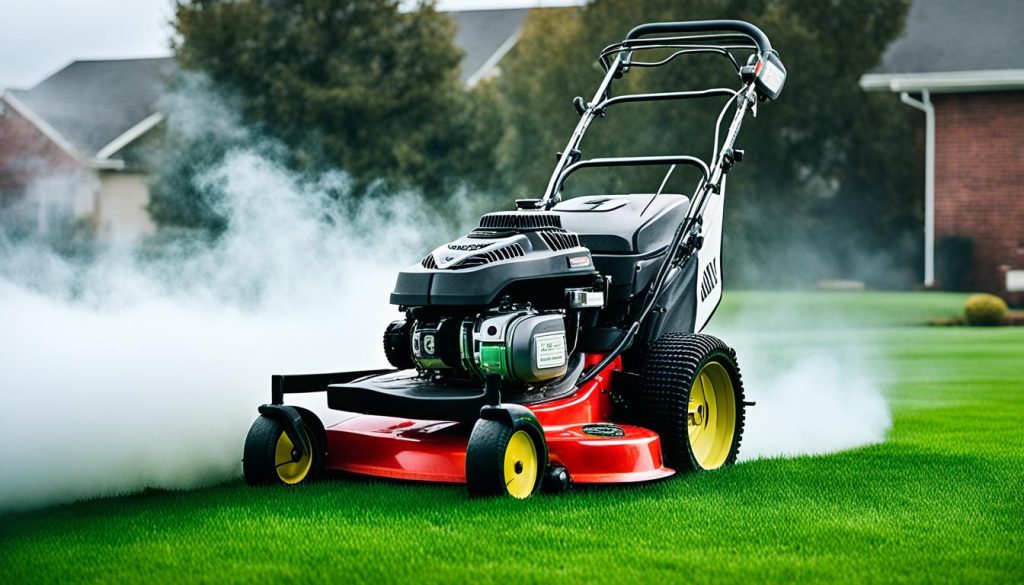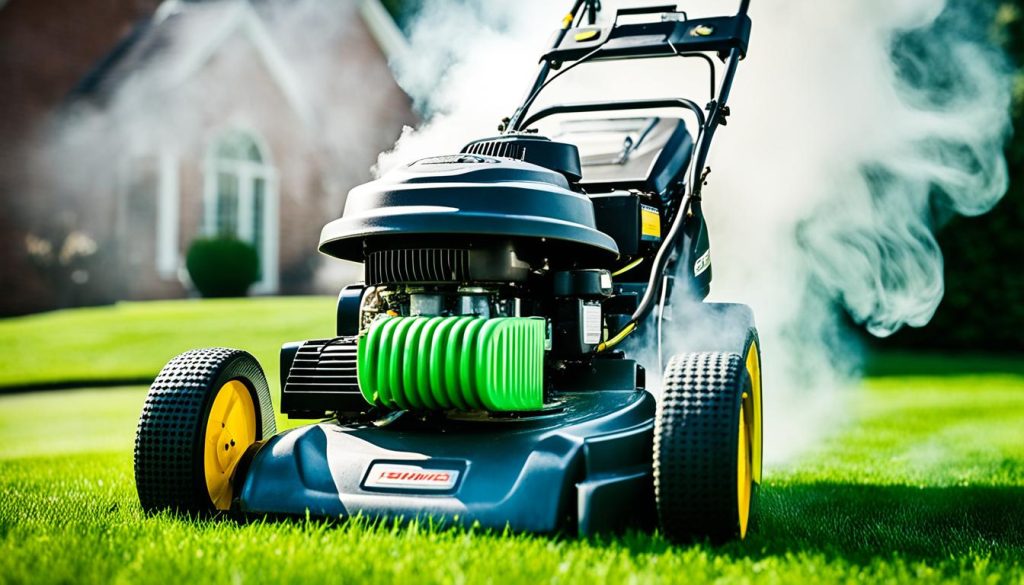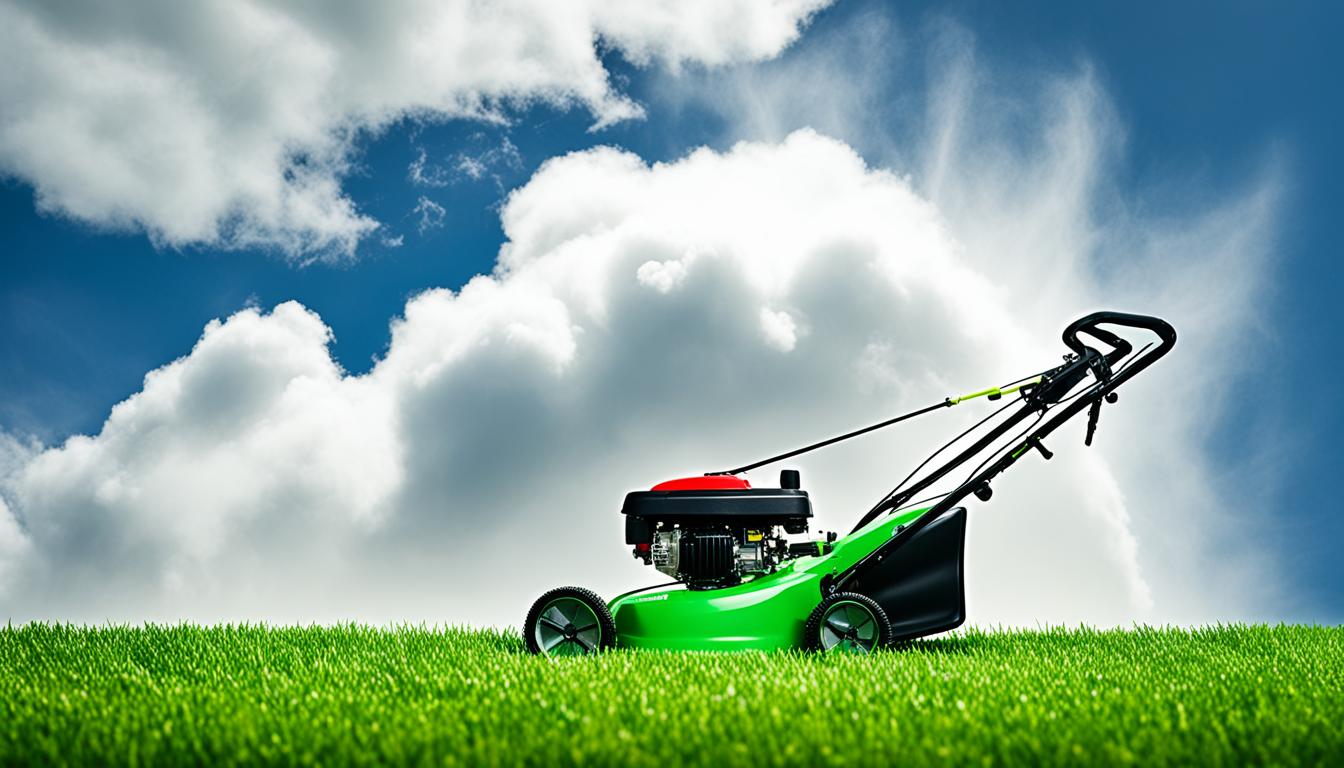Have you ever noticed white smoke billowing from your lawn mower when you try to start it? It’s a puzzling sight that may leave you wondering what could be causing it. Is it a sign of a serious problem or something that can be easily fixed? Let’s dive deeper into the world of lawn mower troubleshooting to uncover the truth behind this phenomenon.
Key Takeaways:
- White smoke from a lawn mower when starting is usually caused by spilled or overfilled oil.
- The smoke is generally harmless and can be fixed with some simple solutions.
- Regular maintenance and proper oil level can help prevent smoke-related issues.
- If the smoke persists or other engine problems arise, professional help may be needed.
- Preventive measures can prolong the lifespan of your mower and reduce potential smoke issues.
What Does White Lawn Mower Smoke Mean?
White smoke from a lawn mower usually indicates an overfilled oil reservoir or oil spilled onto the engine. This can happen if the mower has been turned on its side or if it has mowed on a slope greater than 15 degrees. It can also be caused by a new mower with leftover oil residue. White smoke is generally harmless and can be fixed by burning off the excess oil or draining some oil from the reservoir.
If you see white smoke coming from your lawn mower, don’t panic. The smoke is a result of oil-related issues, most commonly an overfilled oil reservoir or oil spilled onto the engine. This can occur if the mower has been inadvertently tilted on its side or has been operated on a slope greater than 15 degrees. Another possible cause is excessive oil residue in a new mower. While seeing white smoke can be concerning, it is typically not a major cause for alarm.
To tackle the issue, start by allowing the engine to run for a few minutes. In many cases, the excess oil will burn off, and the white smoke will dissipate. If the smoke persists, consider draining some oil from the reservoir to bring it to the correct level. Remember to refer to your owner’s manual for the recommended oil capacity. By adhering to the proper oil level, you can prevent overfilling and minimize the risk of white smoke.
If you recently purchased a new mower, it’s worth noting that some leftover oil residue from the manufacturing process may be the culprit behind the white smoke. Operating the mower for a few hours can help burn off the excess residue and alleviate the issue. However, if the smoke continues or worsens, further investigation may be necessary.
Take a moment to assess whether the mower has recently been turned on its side or operated on a steep slope. If either of these scenarios is applicable, inspect the engine area for any signs of oil spillage. Wipe away any excess oil and ensure that it is not pooling around the engine or other components.
If you’ve exhausted all troubleshooting steps and the white smoke problem persists, it may be time to seek professional assistance. A certified technician can diagnose any underlying issues and provide the appropriate repairs or maintenance.
Table: Common Causes of White Lawn Mower Smoke
| Cause | Description |
|---|---|
| Overfilled Oil Reservoir | Excessive oil in the reservoir due to overfilling, causing white smoke when the mower is running. |
| Oil Spilled onto the Engine | Oil that has dripped or spilled onto the engine, resulting in white smoke during operation. |
| Mower Tilted on its Side | Operating or transporting the mower while tilted can cause oil to enter areas it shouldn’t, leading to white smoke. |
| Slope Greater than 15 Degrees | Mowing on steep slopes can cause oil to shift and enter areas it shouldn’t, resulting in white smoke. |
| New Mower with Oil Residue | Some new mowers have leftover oil residue from the manufacturing process, which can create white smoke initially. |
Quick Fixes for a Smoking Lawn Mower
If you notice white smoke coming from your lawn mower when starting, it’s important to take immediate action for safety. Here are some quick fixes to help resolve the issue:
- Shut off the engine: As soon as you notice the white smoke, turn off the lawn mower. This will prevent any further damage and ensure your safety.
- Remove spark plug (for electric mowers): If you have an electric mower, disconnect the spark plug to reduce the risk of a fire hazard.
- Allow the mower to cool down: Give the mower some time to cool down and let the smoke clear before proceeding with the next steps.
- Check the air filter: A dirty or worn-out air filter can cause the mower to emit white smoke. Remove the air filter and inspect it for any dirt or damage.
- Clean or replace the air filter: If the air filter is dirty, clean it thoroughly. If it’s damaged, replace it with a new one to ensure proper airflow.
- Restart the mower: After cleaning or replacing the air filter, restart the mower. Let it run for a few minutes to burn off any excess oil that may have entered the engine.

Following these quick fixes should help resolve the issue of your lawn mower smoking when starting. However, if the problem persists or you encounter other complications, it’s recommended to seek professional assistance or consult the manufacturer’s manual for further troubleshooting options.
How to Fix White Smoke from Lawn Mower
If the quick fixes don’t resolve the white smoke issue, you may need to identify the specific cause and use the appropriate solution.
-
If the white smoke is due to spilled oil, restart the engine and allow the excess oil to burn off.
-
To prevent future spills, check the owner’s manual for ways to limit oil leaks and avoid mowing on steep slopes.
-
If the white smoke is caused by too much oil, drain some oil from the reservoir to the correct level.
Make sure to use the proper grade of engine oil to avoid further issues.
| Cause | Solution |
|---|---|
| Spilled oil | Allow excess oil to burn off |
| Too much oil | Drain oil to correct level |
Other Smoke Problems
Besides white smoke, a lawn mower may also emit black or blue smoke. Black smoke can indicate a too-rich fuel mixture, often caused by a clogged air filter. Adjusting the carburetor or cleaning/replacing the air filter can help resolve this issue. Blue smoke is usually caused by spilled or excess oil, similar to white smoke. Regular maintenance and keeping the mower in good condition can help prevent smoke problems.
Common Smoke Problems and Solutions:
| Smoke Color | Possible Causes | Solutions |
|---|---|---|
| Black Smoke | Clogged air filter, too-rich fuel mixture | Adjust carburetor, clean/replace air filter |
| Blue Smoke | Spilled or excess oil | Regular maintenance, prevent oil spills |
Note: Proper maintenance and regular inspection of the mower can help prevent and resolve smoke-related problems.

Maintain Both Your Mower and Your Lawn
If the smoke problems persist or if you encounter deeper engine issues, it’s advisable to take your mower to a repair shop. Regularly check your lawn mower to ensure it is in proper working order, from the engine lubrication system to the oil seals. Preventive maintenance and prompt repairs can help extend the lifespan of your mower and reduce potential smoke-related issues.
Here are some essential lawn mower troubleshooting and maintenance tips to keep your mower running smoothly:
- Inspect the Air Filter: Check the air filter regularly and clean or replace it if it is dirty or worn out. A clogged air filter can affect the engine’s performance and increase smoke emission.
- Check the Oil Level: Ensure that the oil level in the reservoir is at the appropriate level as specified in the owner’s manual. Too much oil can lead to smoke issues.
- Use the Correct Grade of Engine Oil: Always use the recommended grade of engine oil for your specific mower model. Using the wrong oil can result in excessive smoke.
- Inspect the Spark Plug: Periodically check the spark plug for signs of wear or damage and replace it if necessary. A faulty spark plug can contribute to smoke problems.
- Monitor the Fuel System: Check the fuel lines, fuel filter, and carburetor for any blockages or leaks. Clean or replace components as needed to ensure proper fuel flow and combustion.
- Keep Blades Sharp: Regularly sharpen the mower blades to ensure clean and efficient cutting. Dull blades can strain the engine and produce excessive smoke.
- Clean the Mower Deck: Remove any debris, grass clippings, or built-up residue from the mower deck to prevent clogs and overheating.
Remember to consult your mower’s owner’s manual for specific maintenance instructions and recommended schedules. Taking proactive steps to maintain both your mower and your lawn can prolong the mower’s lifespan and reduce potential smoke issues.
Diagnosis and Solutions from the Second Source
When it comes to troubleshooting lawn mower smoking, the second source highlights several potential causes and solutions for white smoke issues. One common culprit is a stuck needle in the carburetor, which can lead to improper fuel mixture and white smoke emission. This problem can be resolved by cleaning or replacing the carburetor needle, ensuring proper fuel flow.
Another possible cause is overfilled oil in the crankcase. When the oil reservoir contains excess oil, it can result in gas draining through the crankcase breather tube and adding gas to the oil. To address this issue, it is recommended to check and change the oil at the proper level. Ensuring that the oil is at the right quantity can help eliminate the white smoke problem.
Additionally, it is important to consider the oil grades being used. Incorrect oil grades can contribute to white smoke emission from the lawn mower. Reviewing the owner’s manual and using the recommended oil grades can help prevent smoke issues.
If applicable, priming the engine can also be a solution. By priming the engine, you can ensure that the necessary air-fuel mixture is present and reduce the chances of white smoke during operation.
Overall, diagnosing and solving lawn mower smoking problems requires thorough assessment of the carburetor, oil levels, and oil grades. By addressing these issues, you can effectively troubleshoot white smoke and restore your lawn mower to optimal performance.
Diagnosis and Solutions from the Third Source
The third source provides valuable insights into diagnosing and resolving issues related to smoking lawn mowers. When white or blue smoke emanates from the engine, it is often an indication of burning oil. Several factors can contribute to this problem, including:
- Overfilling the crankcase with oil
- Using incorrect oil grades
- Operating the engine at an angle greater than 15 degrees
- Having a blown head gasket
Identifying the root cause of the smoke is crucial in finding the appropriate solutions. To address these issues, the following steps are recommended:
- Check for leaks in the engine components
- Examine the head gasket for any signs of damage
- Determine if there are worn cylinder rings
Proper maintenance and adherence to the manufacturer’s guidelines are essential to prevent smoke-related problems in lawn mowers. By regularly inspecting and servicing the engine, owners can ensure optimal performance and reduce the risk of smoking issues.
How to Troubleshoot Engine Smoking
If your lawn mower engine is smoking, it’s essential to identify the root cause and take appropriate troubleshooting steps. The third source provides valuable insights into resolving engine smoking issues and getting your mower back in optimal condition.
Check for Tilt or Angle
Before diving into troubleshooting, make sure the engine hasn’t been tilted or used at an angle greater than 15 degrees. If it has, place the mower on a flat surface and allow it to run for a few minutes. This will help clear any smoke caused by the angle of operation.
Inspect and Change the Oil
Checking and changing the oil is an important step in troubleshooting engine smoking. Ensure the oil level is correct and replace it if it appears dirty or contaminated. Using the proper grade of engine oil is crucial to prevent smoke-related issues.
Examine the Crankcase for Leaks
Inspect the crankcase for any signs of leaks. A leaking crankcase can result in oil entering areas it shouldn’t, leading to smoking issues. If you notice any leaks, address them promptly to prevent further damage to the engine.
Examine the Head Gasket, Rings, and Cylinder
The head gasket, rings, and cylinder play vital roles in the engine’s combustion process. If any of these components are damaged or worn, it can contribute to engine smoking. Carefully examine these parts for any signs of wear, leaks, or improper sealing.
Briggs & Stratton Repair Manual
If you encounter specific issues or need detailed repair instructions, the Briggs & Stratton Repair Manual can serve as a valuable resource. It provides comprehensive guidance for troubleshooting and fixing small engine problems, ensuring you have the necessary information to address engine smoking effectively.
Conclusion
White smoke from a lawn mower when starting is often a result of overfilled or spilled oil. Fortunately, resolving this issue is usually a straightforward process that can be tackled by burning off the excess oil or draining some oil from the reservoir. To prevent future smoke-related problems, it is important to engage in regular maintenance practices, such as checking the air filter for cleanliness and ensuring the use of the appropriate grade of engine oil.
However, if the white smoke persists or other engine-related issues arise, seeking professional assistance might be necessary to diagnose and effectively resolve the problem. By taking proactive measures to maintain both your mower and your lawn, you can potentially extend the lifespan of your mower and minimize the likelihood of encountering smoke issues.
Remember, a well-maintained lawn mower is essential for achieving a healthy and vibrant lawn. So, prioritize regular maintenance and troubleshooting techniques to ensure the optimal performance of your lawn mower.





